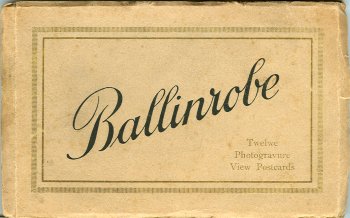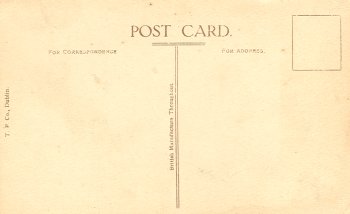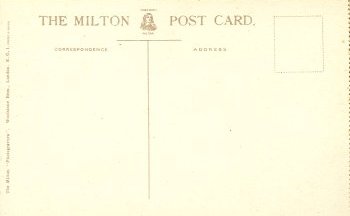My interest in History stems from the day when I bought a set of old postcards of my home town, Ballinrobe, in 1977 for £1. Booklets of them were found in the loft of a local Mace shop, and sold out quickly enough. I was fascinated by the changing landscape of a rural town. Soon after, I put the family camera to good use and tried to rephotograph the scenes for comparison. Now, with the opportunities that computers offer, I've been able to complete the project I set out to do nearly thirty years ago. I hope you enjoy the selection of pictures I've presented for comparison in this site.
Most of the postcards date from about 1925, but some are from an earlier date, about 1912. The older ones are from T P Co., Dublin, and those from the Twenties were sold by The Milton Postcard company. The pictures featured include a number from the Wynne Collection, taken between the years 1870-1890 by the eminent Castlebar photographer Thomas J., who did wonderful work in documenting the places of interest in Mayo at this time. The National Library of Ireland (Click on Photographs, and type in Wynne in the first box) has a fantastic collection of 141 of these pictures and, in addition, collections from other photographers on display. They are well worth a visit to experience life at the end of the Nineteenth Century. The maps are from Mayo County Library's digital version of the 1838 Ordnance Survey Maps of Ireland Each of the 16 pages correspond to views from the past and from the present. On some of the pages, there are additional pictures and information which help children to absorb the strand unit Settlement: homes and other buildings which is a part of the Human Environment Strand of the Geography curriculum. The discussion points under the pictures help children to reason out the possible and probable changes during the 20th Century. These changes encompass the political, social, technological and environmental development of a typical Irish town, thus exploring the strand units of Local History and Irish History in the 20th Century. Skills and concepts involved are listed in the Revised Curriculum: Skills and concepts development for fifth and
sixth classes Working as an historian Time and chronology Methodology: For effective results, the teacher should use a data projector to present initially the old version of the pictures. Class discussion can be directed to describe the scenes, and to predict what changes may have taken place since the early 20th Century. Some discussion points are included under the pictures. It's important that the pupils are challenged in this way. When the teacher thinks it appropriate, just hover the cursor over the picture, and the contemporary photo will appear. Just flick over and back, and discuss the predictions and the actual changes. If a projector is unavailable, pupils could conduct the process independently on a computer in the classroom.
Important technical point: for the rollover old-to-new picture effect to work, your computer browser has to permit active x features. You may be presented with the following warning near the top of your page:
Click on the yellow bar, and choose the option shown:
This site would be most suitable for 3rd to 6th classes. The potential for enhanced learning shouldn't be overlooked: would it be possible for your class to find some old pictures of your locality, and do a field trip to acquire contemporary views? Programs such as Word or Powerpoint could be used to present the results. |






